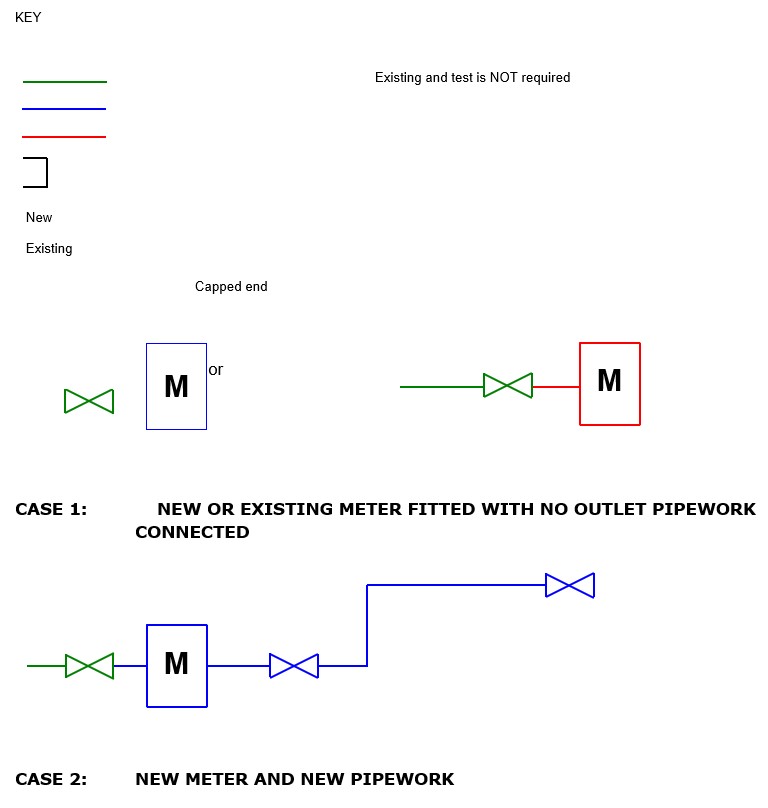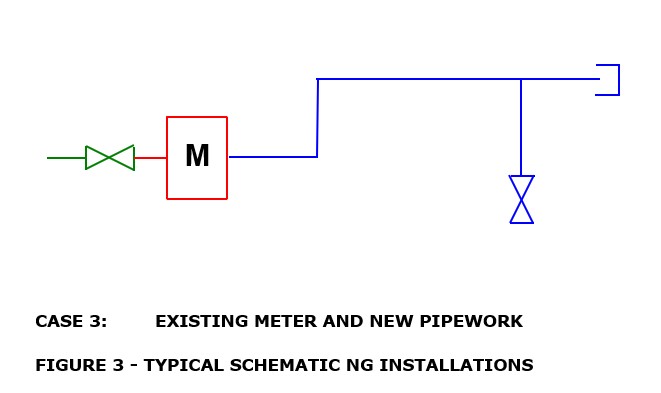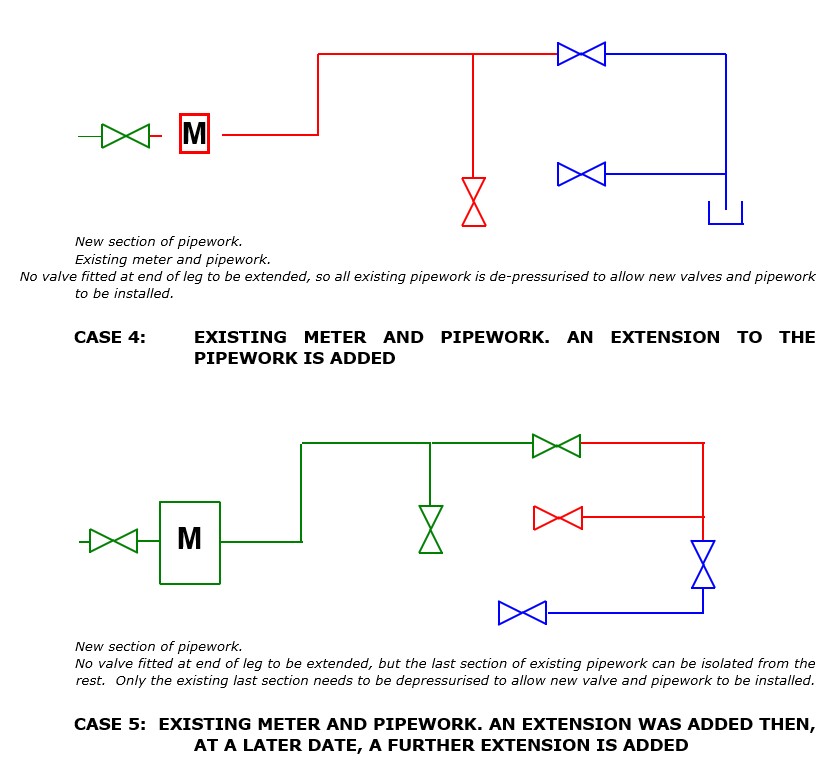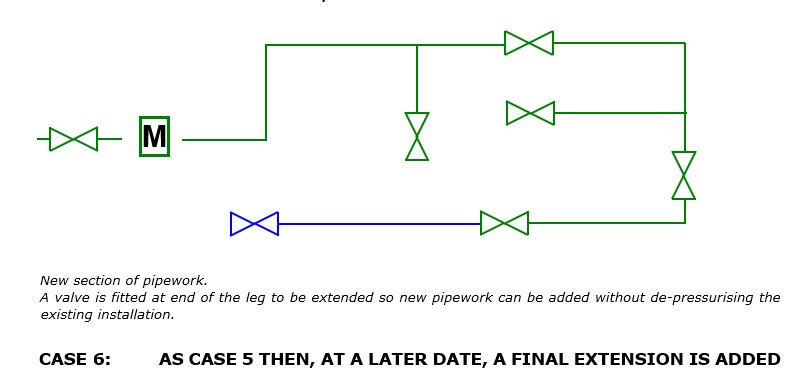IGE/UP/1A Edition 2 +A: 2005 - Strength/tightness testing/purging of small, low pressure industrial & commercial installations
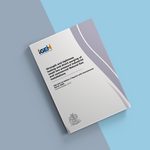
IGE/UP/1 Edition 2 deals with all aspects of strength and tightness testing and direct purging of selected 1st, 2nd and 3rd family gases within its wide scope and at a maximum operating pressure (MOP) not exceeding 16 bar.
IGE/UP/1A Edition 2 deals with the special case of strength and tightness testing and direct purging of installations of volume not exceeding 1 m3 and operating pressure (OP) of not exceeding 40 mbar on industrial and commercial premises, and using Natural Gas (NG), within its scope (see Sub-Section 2.1).
It has been recognised that certain activities outlined in IGE/UP/1 Edition 2 are only required for “large” installations and/or higher pressures and/or other gases and, therefore, the text of UP/1A Edition 2 can be much simpler due to the limited scope.
IGE/UP/1A Edition 2 is intended to assist the operative in understanding and identifying the particular activities of strength and tightness testing and direct purging related to a particular installation.
Certificate pads
The following blank triplicate certificates (in pads of 25) are available to purchase:
Introduction
This Reprint with Amendments of IGE/UP/1A Edition 2 incorporates Amendments as issued in March 2005. It also includes enhancements issued in August 2005. It is essential that owners of the original Procedures i.e those published in 2003 (Communication 1701), update those Procedures with the March 2005 Amendments (which are available to download from IGEM’s website) but it is not essential for those Procedures to be updated with the August 2005 enhancements (which are available to download from IGEM’s website if required but which have no influence on the requirements contained within the Procedures).
For information, the enhancements have been made to Figure 1(key), 2.1
(Note 2), 5.1.2.3, Figure 5, Figure 7 and Figure 8.
The Amendments have been made to Contents, Figure 2, 2.1, 2.2, 2.7, 4.1,
4.2.1, 4.5.11, Figure 4, 5.1.2.4, 5.2.2(d), Table 4, Table 5, Table 6, 5.7.3(d), 5.7.3(f), 5.7.4(a), 5.7.4(c), 5.7.4(d), 5.7.4(f), 5.7.4(h), 5.8.2, 5.8.3, 6.2.6, 6.11.2(a), 6.11.2(g), A3.10, A4.
1.1 These Procedures supersede IGE/UP/1A Edition 1, Communication 1645, which is obsolete. They complement the Procedures IGE/UP/1 Edition 2.
1.2 The term "tightness testing" is now used in European standards. For the purposes of these Procedures, the terms "soundness testing" (as used in IGE/UP/1A Edition 1) and "tightness testing" have an identical meaning.
1.3 IGE/UP/1 Edition 2 deals with all aspects of strength and tightness testing and direct purging of selected 1st, 2nd and 3rd family gases within its wide scope and at a maximum operating pressure (MOP) not exceeding 16 bar.
IGE/UP/1A Edition 2 deals with the special case of strength and tightness testing and direct purging of installations of volume not exceeding 1 m3 and operating pressure (OP) of not exceeding 40 mbar on industrial and commercial premises, and using Natural Gas (NG), within its scope (see Sub-Section 2.1).
It has been recognised that certain activities outlined in IGE/UP/1 Edition 2 are only required for “large” installations and/or higher pressures and/or other gases and, therefore, the text of UP/1A Edition 2 can be much simpler due to the limited scope.
IGE/UP/1A Edition 2 is intended to assist the operative in understanding and identifying the particular activities of strength and tightness testing and direct purging related to a particular installation.
Note 1: Strength testing has been introduced for new pipework and extensions to ensure that pipework can withstand, with respect to integrity, the pressures it could experience under fault conditions. A result of carrying out a strength test is that the subsequent tightness test is carried out at OP and not at higher pressures as was the case with Edition 1. For IGE/UP/1A applications, the strength and tightness tests may be carried out separately or be combined or be carried out concurrently.
Note 2: “MOP” and other new terms such as “maximum incidental pressure” (MIP) and OP have been introduced to reflect gas pressure terminology used in European standards. Appendix 1 defines these terms and it is possible to equate them to terms used in Edition 1. These terms will arise in all relevant IGEM technical publications in future and, possibly, in other standards.
Referring to Figure 1, note how OP is shown to oscillate about the set point (SP). Note also that MOP can be declared at any value from OP to a limit below MIP.
For a new system of installation pipework, the onus is on the designer to establish both MIP and MOP. For an existing system of installation pipework, the onus is on the designer/owner of the system to ensure that any increase in pressure within the system will not result in OP exceeding MOP of the system and on the gas transporter/meter asset manager (GT/MAM) to ensure that any change in their pressure regimes due to fault conditions will not jeopardise the safety of the downstream system. This involves effective communication between the GTs/MAMs and system designers/owners.
IGE/UP/1B deals with tightness testing and purging of domestic-sized NG installations.
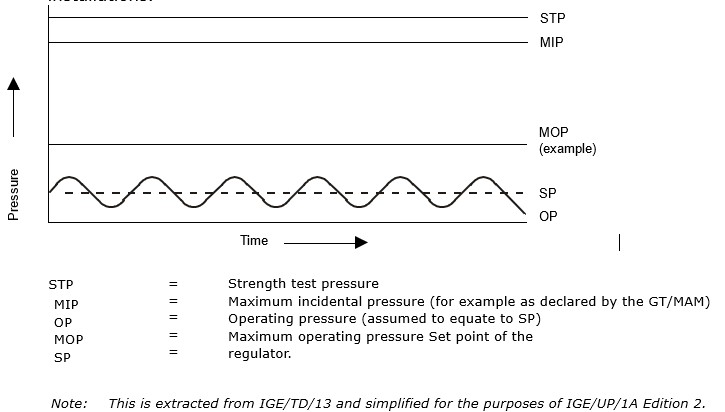
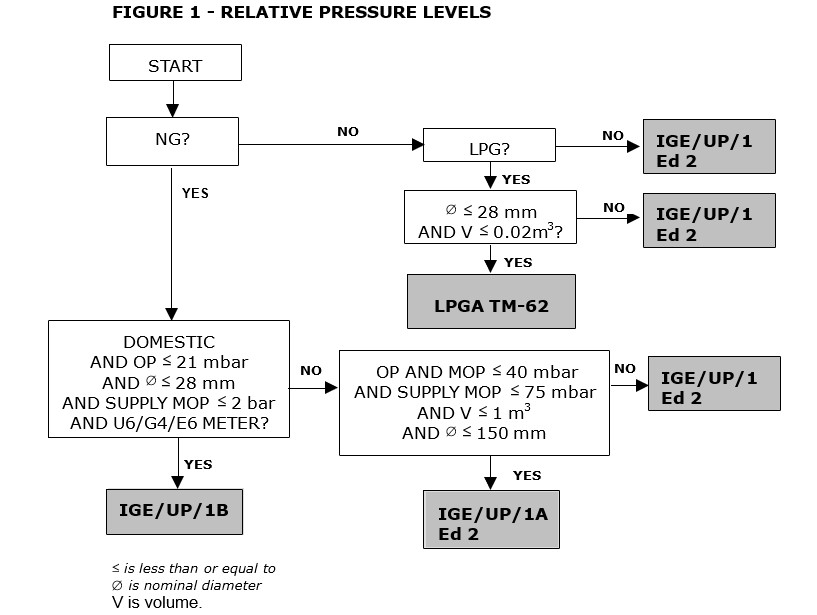
Note: This shows the most suitable standard for a particular situation. If IGE/UP/1A Edition 2 or IGE/UP/1B or LPGA TM-62 are not indicated, it is essential that IGE/UP/1 Edition 2 is used. If it is preferred (it is not recommended, as it is more complex to follow) IGE/UP/1 Edition 2 can be used rather than IGE/UP/1A Edition 2 or IGE/UP/1B or LPGA TM-62. At the time of publication, neither IGE/UP/1B nor LPGA TM-62 require strength testing.
It is necessary to check the scope of referenced standards before proceeding.
FIGURE 2 - ALGORITHM TO SELECT TESTING AND PURGING STANDARDS LPGA-TM 62 deals with tightness testing of domestic-sized liquefied petroleum gas (LPG) pipework (volume not exceeding 0.02 m3). For greater volume, IGE/UP/1 Edition 2 applies.
Figure 2 will assist in selecting the appropriate standard.
1.4 There are several reasons why it was necessary to introduce a 2nd edition of IGE/UP/1A, including:
- to take into account changes in technology and application since IGE/UP/1A Edition 1 was published
- to align with IGE/UP/1 Edition 2
- to simplify the decision making and calculations while retaining the same standards of safety. The basic concept of ensuring a maximum safe energy release remains
- comments had been made suggesting the layout of Edition 1 could be improved.
1.5 These Procedures make use of the terms “should”, “shall” and “must” when prescribing particular procedures. Notwithstanding Sub-Section 1.8:
- the term “must” identifies a requirement by law in Great Britain at the time of publication
- the term “shall” prescribes a procedure which, it is intended, will be complied with in full and without deviation
- the term “should” prescribes a procedure which, it is intended, will be complied with unless, after prior consideration, deviation is considered to be acceptable.
Such terms may have different meanings when used in legislation, or Health and Safety and Executive (HSE) Approved Code of Practice (ACoPs) or guidance, and reference needs to be made to such statutory legislation or official guidance for information on legal obligations.
1.6 The primary responsibility for compliance with legal duties rests with the employer. The fact that certain employees, for example “responsible engineers”, are allowed to exercise their professional judgement does not allow employers to abrogate their primary responsibilities. Employers must:
- have done everything to ensure, so far as it is reasonably practicable, that “responsible engineers” have the skills, training, experience and personal qualities necessary for the proper exercise of professional judgement • have systems and procedures in place to ensure that the exercise of professional judgement by “responsible engineers” is subject to appropriate monitoring and review
- not require “responsible engineers” to undertake tasks which would necessitate the exercise of professional judgement that is not within their competence. There should be written procedures defining the extent to which “responsible engineers” can exercise their professional judgement. When “responsible engineers” are asked to undertake tasks which deviate from this they should refer the matter for higher review.
1.7 It is now widely accepted that the majority of accidents in industry generally are in some measure attributable to human as well as technical factors in the sense that actions by people initiated or contributed to the accidents, or people might have acted in a more appropriate manner to avert them.
It is therefore necessary to give proper consideration to the management of these human factors and the control of risk. To assist in this, it is recommended that due regard be paid to HS(G)48.
1.8 Notwithstanding Sub-Section 1.6, these Procedures do not attempt to make the use of any method or specification obligatory against the judgement of the responsible engineer. Where new and better techniques are developed and proved, they should be adopted without waiting for modification to these Procedures. Amendments to these Procedures will be issued when necessary, and their publication will be announced in the Journal of the Institution and other publications as appropriate.
1.9 Requests for interpretation of these Procedures in relation to matters within their scope, but not precisely covered by the current text, should be addressed in writing to Technical Services, The Institution of Gas Engineers and Managers (IGEM), Charnwood Wing, Ashby Road, Loughborough, Leics, LE11 3GR and will be submitted to the relevant Committee for consideration and advice, but in the context that the final responsibility is that of the engineer concerned. If any advice is given by or on behalf of IGEM, this does not relieve the responsible engineer of any of his or her obligations.
1.10 These Utilization Procedures were published on 28th October 2003. They may be used rather than IGE/UP/1A Edition 1 immediately but a lead-in period is allowed, permitting the use of Edition 1 until 28th January 2004.
1.11 Italicised text is informative and does not represent formal Procedures.
1.12 Appendices are informative and do not represent formal Procedures unless specifically referenced in the main sections via the prescriptive terms “should”, “shall” or “must”.
Scope
2.1 These Procedures apply to any section of pipework (see Sub-Section 2.2) from the outlet of the emergency control valve (ECV) (fitted on the end of the gas service).
Note 1: This includes any primary or secondary meter installation.
Note 2: These Procedures may be applied for risers and laterals.
Typical installations are shown in Figure 3.
See additional text in 2.1(A) at base of page.
2.2 These Procedures apply to any section of pipework having:
- a volume of not exceeding 1 m3 including any meter and any allowance for fittings
- an MOP not exceeding 40 mbar at the outlet of the primary meter regulator
- a supply MOP not exceeding 75 mbar • a nominal bore not exceeding 150 mm.
Note 1: The Procedures can be used for pipework exceeding 28 mm diameter on domestic premises. For pipework of diameter not exceeding 28 mm on domestic premises, IGE/UP/1B applies.
Note 2: The diversity of industrial and commercial gas installations is such that it is inappropriate to provide detailed guidelines for all types of installation covered by the scope of these Procedures. It is recognised that special circumstances may occur, on an installation, for which some of these Procedures cannot be applied. In such a case, for example where the volume of pipework cannot be readily calculated, whether testing or purging, a specific testing or purging procedure needs to be developed that has a comparable sensitivity and level of safety. The procedure needs to be developed by personnel of adequate competency and experience.
Note 3: For a volume exceeding 1 m3, or MOP exceeding 40 mbar, or a supply MOP exceeding 75 mbar, or a nominal bore exceeding 150 mm, IGE/UP/1 applies.
Note 4: See Sub-Section 2.7 regarding the principles adopted for the detection of leakage.
2.3 These Procedures cover strength and tightness testing, and direct purging, of pipework containing Natural Gas (NG).
Note: For other gases, IGE/UP/1 applies.
2.4 These Procedures apply to strength testing and/or tightness testing pipework in the following circumstances:
- new pipework
- alteration to, replacement of, re-use of, or uprating (for example increasing OP) existing pipework
- new extensions to existing pipework
- prior to any work (see Appendix 1) on existing pipework
- where there is a known or suspected gas leak in pipework
- where there has been a complete loss of pressure for any reason
Note: The closure of a valve, for example the ECV, can result in a complete loss of pressure which necessitates tightness testing and purging before resumption of supply. - routine testing of existing pipework
- immediately before purging pipework (except when taking pipework permanently out of service).
Note: If considering strength testing of existing pipework, refer to clause 4.2.2.
2. 1(A) However, any new pipework between the ECV and the inlet of the first regulator downstream of the ECV is excluded from the scope unless it has been pre-tested for strength and tightness prior to assembly.
2.5 These Procedures apply to direct purging in the following circumstances:
- new pipework
- alteration to, replacement of or re-use of existing pipework
- new extensions to existing pipework
- where there has been a complete loss of pressure for any reason
Note: The closure of a valve, for example the ECV, can result in a complete loss of pressure which necessitates tightness testing and purging before resumption of supply. - where there is the possibility of air being present in pipework • where pipework is to be taken out of service temporarily or permanently.
2.6 All pressures quoted are gauge pressures unless otherwise stated.
2.7 IGE/UP/1A Edition 2 adopts the concept of “gauge readable movement (GRM)”. When using a water gauge, it may be possible to reduce the duration of tests for new installations and extensions by adopting the concept of “no perceptible movement” (see Appendix 4).
